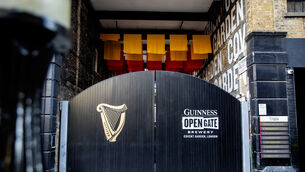US shares jittery over inflation
Stocks rose, dropped and then recovered today – just as they did over the course of the first quarter, as Wall Street showed nervousness about rising inflation and dollar weakness but took solace in resilient consumer spending and slow but steady economic growth.
The Dow Jones industrials finished the day 5 points higher, and ended the quarter down about 108 points, or 0.87%, the blue chip index’s most feeble performance since the second quarter of 2005.
Stocks had initially climbed today after data showed a rise in consumer spending and growth in Chicago-area manufacturing. But in late morning trading, they reversed course when the Bush administration detailed economic sanctions against China to protect American paper producers from what it called unfair Chinese government subsidies.
The news caused the dollar to weaken, raising concerns in the market about the US currency’s status as an investment vehicle – one of the factors behind the market’s big drop in late February.
The Commerce Department reported that core inflation rose in February at the fastest rate since August, which also caused wariness among investors.
However, investors, shoring up their portfolios as the first quarter ended and picking up bargain stocks, managed to pull the market up from its lows of the day.
“It’s been kind of a rough quarter. There have been some shocks out there. And the retail investor has been taking it in stride,” said Scott Merritt, US equity strategist at JPMorgan Asset Management.
The Dow rose 5.60 points, or 0.05%, to 12,354.35, after rising 67 points and then falling by 106 earlier in the session. It saw its first quarterly decline since falling more than 2% in the second quarter of 2005, but is more than 300 points above its levels in early March.
Broader stock indicators were mixed. The Standard & Poor’s 500 index lost 1.67, or 0.12%, to 1,420.86, and the technology-dominated Nasdaq composite index rose 3.76, or 0.16%, to 2,421.64.
The S&P 500 and Nasdaq both finished the quarter less than 1% higher, posting their most meagre performance, both point-wise and percentage-wise, since the second quarter of 2006.
Bonds slipped, with the yield on the benchmark 10-year Treasury note rising to 4.65% from 4.64% late Thursday. Gold prices rose.
The dollar fell against other major currencies after news of the sanctions against China – notably the yen, which many investors borrow with to buy higher-yielding dollar assets. If the dollar weakens too much, dollar assets will become less attractive – a problem for the stock market.
Crude oil prices retreated after surpassing a six-month high this week, which heightened worries about high fuel costs eating into discretionary spending. Crude slipped 16 cents to 65.87 dollars a barrel on the New York Mercantile Exchange.
Energy prices were not the only problem: the inflation barometer which excludes energy and food shot up by 0.3% in February, the Commerce Department said, leaving core inflation rising by 2.4% over the past 12 months.
“It’s stubbornly above the Fed’s comfort zone,” said Mr Merritt, noting that investors have been hoping that the Federal Reserve would lower interest rates later this year.
“They’re afraid that they’re going to take their sweet time making rate cuts.”
But investors took comfort in other data today, which overall painted a picture of cool economic growth.
A University of Michigan survey showed that consumer confidence slipped in March from a month earlier, but the Commerce Department reported today that personal spending rose in February by the largest amount in 11 months, a good sign that the economy will keep chugging along, especially since recent data has shown stability in the job market.
Also, the index of Chicago area manufacturing activity soared to a reading of 61.7 in March, higher than the Street expected and up from 47.9 in February. A reading above 50 indicates expansion, and a reading below 50 shows contraction. The report is often a good indicator of Monday’s national manufacturing report from the Institute for Supply Management.
Construction spending in January rose by a better-than-expected 0.3%, up from a 0.8% fall in December. Housing construction fell sharply but was offset by strong gains in non-residential spending and local projects, suggesting that the slow housing market isn’t ruining other areas of the economy.
Meanwhile, the government’s spring planting report showed farmers expect to plant 90.5 million acres of corn this spring. The US Department of Agriculture had expected about 86 million acres.
“Inflation is a worry, so the market is reacting in a tepid way to what I considered fairly good economic news,” said Richard Hoyt, market strategist for KDV Wealth Management in Minneapolis.
Concern that the economy is slowing too quickly has been a big factor in the market’s volatility this quarter.
The major stock indexes started out strongly in January, with the Dow extending its record-setting advance which began in 2006, and hitting a peak of 12,786.62 on February 20. But stocks then tumbled, with the Dow plummeting 416 points on February 27 as various worries – about the possibility of recession, a stock dive in China, the floundering subprime mortgage market, and the dollar weakening against the yen – came to a head.
The Dow fell to its lowest close of the quarter on March 5 at 12,050.41, and briefly dipped below the psychological 12,000 mark on March 14. But investors managed to keep the market from spinning out, steering the indexes back toward January levels thanks to reassuring economic data and calming words from the Fed.
Mr Merritt noted that for a stock dive to be officially considered a correction, it should exceed 10%, and the recent decline did not.
Volatility remains higher than it was before the big dive, and investors will be looking at first-quarter earnings reports next month to see if the corporate growth is retreating slowly, as expected, or dropping off precipitously.
Advancing issues narrowly outnumbered decliners on the New York Stock Exchange, where volume came to 1.59 billion shares, up from 1.51 billion shares yesterday.
The Russell 2000 index of smaller companies rose 1.77, or 0.22%, at 800.71. It finished up 1.66% for the first quarter.
AP
















